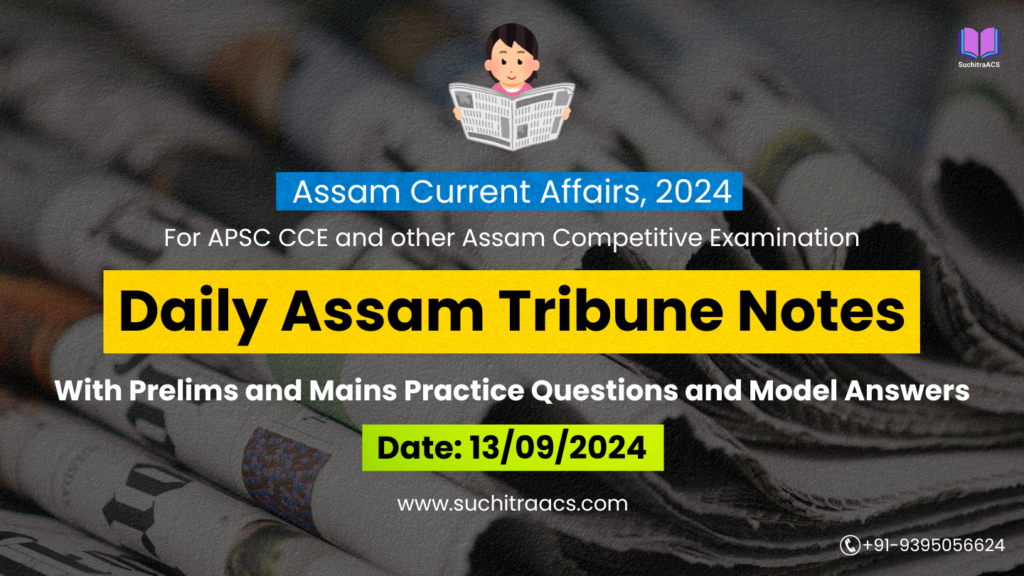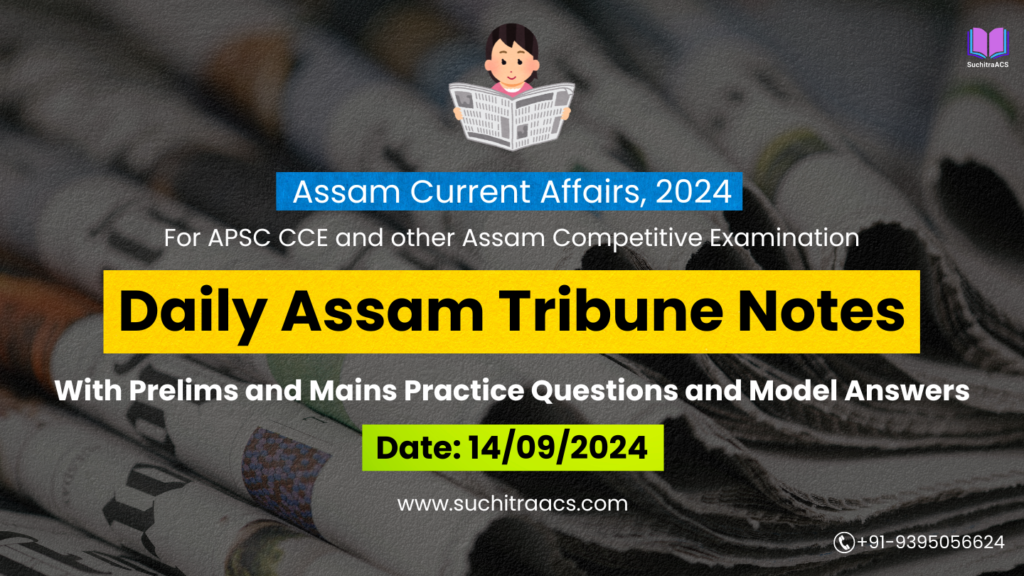1. Drought-like Situation Impacts Agriculture
Relevance to APSC CCE Syllabus:
Prelims: This topic directly connects with the General Studies Paper-I, testing your awareness of current events and issues specifically related to Assam’s agriculture and the prevalent climatic conditions.
Mains: It significantly contributes to the General Studies Paper III, under the sections of Disaster Management and Agriculture. Additionally, for the Assam-specific paper (GS-V), it is pertinent to the areas of Economic Development, Biodiversity, and Environment.
Comprehensive Notes:
Underlying Causes: The primary trigger for this drought-like situation is the substantial deficit in rainfall experienced in Assam during September. The state has received only 80.8 mm of rainfall this month, a stark contrast to the normal expected rainfall of 213.9 mm, indicating a 62% deficit. Furthermore, the unusually high temperatures have exacerbated the situation, creating a challenging environment for crops.
Crops in Peril: The adverse effects of this drought are already visible across various crops. Rice, a staple crop in Assam, is exhibiting signs of stress with yellowing of paddy fields and increased weed growth due to the lack of standing water. The tea industry, a cornerstone of Assam’s economy, is also facing challenges. The dry spell has hampered plant growth, and the persistent pest problem is further compounded by the risky application of pesticides under these conditions. Scorching of tea plants has been observed, impacting their metabolism and physiology. Lemon orchards in Tinsukia are also showing signs of scorching due to the intense heat.
Projected Impact: Experts predict a significant impact on agricultural yield across the state. The tea crop for September is anticipated to decrease by at least 15%. The overall impact on rice production is yet to be fully assessed, but the combination of drought stress and increased weed pressure is likely to result in reduced yields.
Critical Concerns: The limited availability of functional irrigation facilities in Assam is a major concern. While officially around 15% of agricultural land has irrigation, the actual functional coverage is less than 6%. This leaves a vast majority of farmers vulnerable to the vagaries of the monsoon, making them particularly susceptible to drought conditions.
Government’s Response: In response to the crisis, the Assam Agriculture University (AAU) has expedited the development of a drought-resistant Sali paddy variety. This new variety has already been recommended by the university and is awaiting official notification. This proactive step aims to equip farmers with a resilient crop option in the face of future droughts.
Areas for Further Research: To gain a comprehensive understanding of the situation, further research is needed to assess the impact of the drought on other crops beyond rice, tea, and lemon. It is also crucial to investigate the long-term effects of this drought on Assam’s agriculture and explore adaptation strategies that farmers can adopt to mitigate the impact of such climatic events in the future.
2. Sri Lanka’s Presidential Elections
Relevance to APSC CCE Syllabus:
Prelims: This topic falls under the ambit of current affairs and international relations, both of which are crucial components of the General Studies Paper-I.
Mains: It is directly relevant to the General Studies Paper-II, under the section of International Relations.
Comprehensive Notes:
Election Outcome: The recent presidential elections in Sri Lanka witnessed the victory of Anura Kumara Dissanayake, the leader of the Marxist Janatha Vimukthi Peramuna party’s broader front, the National People’s Power (NPP). This marks a significant turning point in Sri Lankan politics, as Dissanayake is the first-ever Marxist party leader to assume the presidency.
Campaign Strategy: Dissanayake’s campaign resonated with the electorate, particularly the youth, by focusing on anti-corruption measures and promising a transformation in the country’s political culture. This message gained traction in the wake of the economic crisis and the subsequent mass protests that led to the ousting of Gotabaya Rajapaksa in 2022.
Challenges Ahead: The new president faces a multitude of challenges, including navigating the country out of its economic crisis, addressing political instability, and fulfilling the expectations of the people who voted for change.
India’s Perspective: Dissanayake’s visit to India earlier this year is seen as a positive development from India’s perspective. It suggests a potential shift in the NPP leadership’s approach towards India, indicating a willingness to align with foreign investment interests, which could have implications for India-Sri Lanka economic ties.
Areas for Further Research: To gain deeper insights, it is important to research the specific policies and agenda of the NPP, the potential implications of Dissanayake’s presidency for Sri Lanka’s domestic and foreign policies, and the future trajectory of India-Sri Lanka relations under the new leadership.
3. US Returns Smuggled Antiquities to India
Relevance to APSC CCE Syllabus:
Prelims: This topic is linked to current affairs and highlights India’s rich heritage and culture, making it relevant for the General Studies Paper-I.
Mains: It directly connects with the General Studies Paper-I, under the section of Indian Heritage and Culture.
Comprehensive Notes:
Repatriation of Antiquities: The United States has recently returned 297 antiquities to India that were smuggled out of the country. This act signifies a strengthening of cultural ties between the two nations and underscores their commitment to combating the illicit trafficking of cultural property.
Significance of the Returned Artifacts: The returned antiquities include a diverse range of objects, such as a sandstone ‘apsara,’ a Jain Tirthankar in bronze, a terracotta vase, and a stone sculpture of Lord Vishnu. These artifacts represent various periods of Indian history and hold immense cultural and historical value.
India’s Efforts in Recovering Antiquities: Since 2014, India has successfully recovered a total of 640 ancient items, with 578 of them being returned from the US alone. This demonstrates the Indian government’s proactive approach in reclaiming its stolen cultural heritage.
Bilateral Cooperation: The India-US Cultural Property Agreement, signed in July 2024, aims to prevent and curb the illicit trafficking of antiquities between the two countries. This agreement signifies a significant step in international cooperation for heritage protection.
Areas for Further Research: To delve deeper into this topic, one can research the specific details and historical context of the returned antiquities. Additionally, exploring other international collaborations and initiatives undertaken by India to protect its cultural heritage would provide a broader perspective.
4. Rhino Poaching in Assam
Relevance to APSC CCE Syllabus:
Prelims: This topic pertains to environment and conservation efforts, particularly concerning Assam’s wildlife, making it relevant for the General Studies Paper-I.
Mains: It is directly linked to the General Studies Paper-III, under the sections of Biodiversity and Environment, as well as the Assam-specific paper (GS-V), under the same sections.
Comprehensive Notes:
Positive Trend: On the occasion of World Rhino Day, Chief Minister Himanta Biswa Sarma highlighted a significant achievement in Assam’s conservation efforts. He stated that rhino poaching in the state has decreased by 86% since the BJP government came to power in 2016.
Government’s Commitment: Both Prime Minister Narendra Modi and the Assam government have reaffirmed their dedication to protecting the rhinoceros, recognizing its iconic status and the importance of conservation efforts.
Key Factors Contributing to Success: The decline in rhino poaching can be attributed to a combination of factors, including enhanced security measures, expansion of protected areas, and active engagement with local communities who play a crucial role in safeguarding wildlife.
Population Growth: Thanks to these conservation efforts, the rhino population in Assam has witnessed a remarkable increase. From a mere 600 in the 1960s, the population has now grown to over 3,000, showcasing the effectiveness of the conservation strategies implemented.
Areas for Further Research: To gain a deeper understanding, it would be beneficial to research the specific anti-poaching measures undertaken, the challenges faced in rhino conservation, and the evolving role of local communities in these efforts.
5. Coal Mine Blast in Iran
Relevance to APSC CCE Syllabus:
Prelims: This incident falls under international current affairs and disaster management, both of which are important for the General Studies Paper-I.
Mains: It is directly relevant to the General Studies Paper-III, under the section of Disaster Management.
Comprehensive Notes:
Tragic Incident: A devastating explosion occurred in a coal mine in eastern Iran, resulting in a significant loss of life. At least 34 miners were killed, 17 injured, and several others remain missing.
Cause of the Disaster: The blast was triggered by a methane gas leak, a common hazard in mining operations. Despite the prevalence of such risks, modern safety protocols emphasize the importance of ventilation and other protective measures to safeguard miners.
Safety Concerns: The incident raises concerns about the safety procedures in place at the privately-owned Mandanjoo Co, which operated the Tabas Parvadeh 5 mine. The lack of clarity regarding these procedures has fueled public apprehension and calls for greater transparency in wildlife management practices.
Areas for Further Research: To gain a more nuanced understanding, it is essential to delve into the specific protocols and guidelines followed in wildlife translocation operations, particularly concerning the handling and transportation of tranquilized animals. Additionally, examining the role of public awareness and community engagement in wildlife conservation efforts would provide valuable insights.
APSC Prelims Practice Questions
1. Drought-like Situation in Assam
- Question: The drought-like situation in Assam during September 2024 has been primarily attributed to:
(A) Excessive deforestation in the state
(B) El Niño effect leading to altered weather patterns
(C) A significant deficit in rainfall coupled with high temperatures
(D) Inadequate water management practices in agricultural areas
- Answer: (C) A significant deficit in rainfall coupled with high temperatures
- Explanation: This question directly assesses the candidate’s understanding of the causes of the drought, aligning with the General Studies Paper-I (current events) and Paper-III (disaster management) of the APSC CCE syllabus.
2. Sri Lanka’s Presidential Elections
- Question: The victory of Anura Kumara Dissanayake in the 2024 Sri Lankan presidential election is significant because:
(A) He is the first Marxist leader to become the President of Sri Lanka
(B) He represents a shift away from traditional political parties
(C) His campaign focused on economic reforms and foreign investment
(D) He enjoys strong support from the Tamil minority population
- Answer: (A) He is the first Marxist leader to become the President of Sri Lanka
- Explanation: This question tests the candidate’s knowledge of international current affairs and its implications, aligning with the General Studies Paper-I (current events) and Paper-II (international relations) of the APSC CCE syllabus.
3. US Returns Smuggled Antiquities to India
- Question: The recent return of 297 antiquities by the US to India is a significant step towards:
(A) Strengthening cultural ties between the two nations
(B) Combating the illicit trafficking of cultural property
(C) Preserving India’s rich historical and cultural heritage
(D) All of the above
- Answer: (D) All of the above
- Explanation: This question comprehensively covers the various dimensions of the event, including its cultural, legal, and heritage preservation aspects, aligning with the General Studies Paper-I (Indian heritage and culture) of the APSC CCE syllabus.
4. Rhino Poaching in Assam
- Question: Which of the following factors have contributed to the decline in rhino poaching in Assam since 2016?
(i) Enhanced security measures
(ii) Expansion of protected areas
(iii) Community engagement
(iv) Increased international funding for conservation
Select the correct answer using the codes given below:
(A) (i) and (ii) only
(B) (i), (ii) and (iii) only
(C) (ii) and (iv) only
(D) (i), (ii), (iii) and (iv)
- Answer: (B) (i), (ii) and (iii) only
- Explanation: This question tests the candidate’s understanding of the multi-pronged approach to wildlife conservation, aligning with the General Studies Paper-III (biodiversity and environment) and Paper-V (biodiversity and environment of Assam) of the APSC CCE syllabus.
5. Coal Mine Blast in Iran
- Question: The coal mine explosion in eastern Iran highlights the critical importance of:
(A) Stricter regulations on private ownership of mines
(B) Implementing robust safety protocols in mining operations
(C) Investing in advanced technologies for gas leak detection
(D) Increasing international cooperation in disaster management
- Answer: (B) Implementing robust safety protocols in mining operations
Explanation: This question focuses on the core issue of mining safety and its relevance to disaster management, aligning with the General Studies Paper-III (disaster management) of the APSC CCE syllabus.
APSC Mains Practice Question
Question: The recent incident of a Royal Bengal tiger’s death during a translocation operation in Assam has raised concerns about wildlife management practices in the state. Discuss the challenges associated with wildlife translocation and suggest measures to improve the safety and success of such operations. (250 words)
Model Answer:
Wildlife translocation, the process of moving animals from one location to another, is a complex and challenging undertaking with significant implications for both the animals and the ecosystems involved. The recent tragic incident in Assam, where a Royal Bengal tiger died during a translocation operation, underscores the critical need to address the challenges associated with such endeavors and implement measures to ensure the safety and well-being of the animals.
Challenges in Wildlife Translocation:
- Stress and Trauma: The capture, handling, and transportation of wild animals can induce significant stress and trauma, potentially compromising their health and survival.
- Habitat Suitability: Ensuring the new habitat is suitable for the translocated animals, providing adequate food, water, and shelter, is crucial for their successful adaptation.
- Disease Transmission: Translocation can facilitate the spread of diseases between animals and populations, posing a threat to both the translocated individuals and the existing wildlife in the new habitat.
- Human-Wildlife Conflict: Translocated animals may come into conflict with humans in the new area, leading to negative interactions and potential harm to both.
- Monitoring and Management: Post-release monitoring and management are essential to track the animals’ movements, assess their adaptation, and address any potential conflicts or challenges.
Measures to Improve Wildlife Translocation:
- Thorough Planning and Assessment: Conduct comprehensive pre-translocation assessments, including habitat suitability analysis, health screenings, and risk assessments, to minimize potential problems.
- Minimizing Stress and Trauma: Employ humane capture and handling techniques, ensure proper sedation and veterinary care during transportation, and provide adequate space and comfort for the animals.
- Disease Prevention: Implement strict quarantine and health protocols to prevent the introduction and spread of diseases.
- Community Engagement: Involve local communities in the translocation process, raise awareness about the importance of wildlife conservation, and address potential human-wildlife conflicts through education and outreach programs.
- Post-Release Monitoring and Management: Conduct regular monitoring of translocated animals, track their movements, assess their health and behavior, and intervene if necessary to ensure their successful adaptation and minimize conflicts.
- Capacity Building and Training: Provide comprehensive training to wildlife managers and field staff on animal handling, sedation, transportation, and post-release monitoring techniques.
Conclusion:
Wildlife translocation, while a valuable tool for conservation, requires meticulous planning, careful execution, and continuous monitoring to ensure the well-being of the animals and the success of the operation. By addressing the challenges and implementing the suggested measures, we can enhance the safety and effectiveness of wildlife translocation efforts, contributing to the preservation of our precious biodiversity.
✨ Looking for top-quality APSC online coaching at an affordable price?

🔔 Join Our WhatsApp Study Group!
For exclusive access to premium quality content, including study materials, current affairs, MCQs, and model answers for APSC CCE and other Assam competitive exams.
Click here to join: SuchitraACS Study WhatsApp Group
📚 Want to know more about SuchitraACS’s most affordable courses?
Click here to know more: SuchitraACS Courses for APSC CCE and Assam Competitive Examinations



